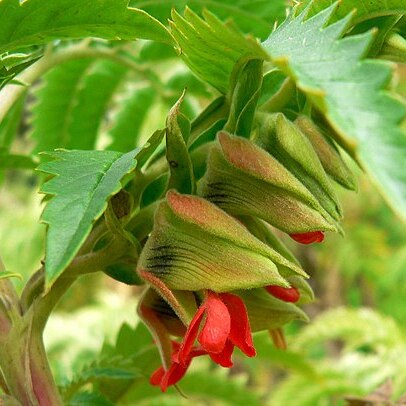Erect shrub to 2 (–3) m high, downy with stellate hairs. Leaves imparipinnate, to 15 cm long, with foul odour; leaflets 9–11, oblong to lanceolate, deeply serrate, to 6 cm long, to 2 cm wide, markedly discolorous, dark green with sparse minute stellate hairs (sometimes glabrescent) above, grey-tomentose below; stipules narrowly lanceolate, free. Inflorescence a dense axillary raceme, subsessile, to 10 cm long. Sepals very unequal, greenish, the longest 1–2 cm long, the shortest (abaxial) saccate at base. Petals 4, unequal, 2 sometimes bifid, shortly exceeding abaxial sepal, red. Ovary 4-lobed; style c. equal to stamens. Capsule 2.5–3 cm long, 4-winged, membranous, stellate-downy. Seeds 1 or 2 per locule, ovoid to subglobose, 4–5 mm long, black, shiny.
More
A shrub. It grows 1.5 m tall. The leaves are 6-16 cm long and divided in the top section. The leaflets in a pairs are 3-5 cm long and 0.5-2 cm wide. The flowering shoots hang down with flowers along them. The flowers are dark red. The fruit capsules are 3-5 cm long and have 4 wings. The seeds are 3-4 mm across. They are black and shining.
Recorded from disturbed weedy areas, along watercourses, in scrub, bushland, beach dunal areas, roadsides and paddocks.
More
It is a subtropical plant.


